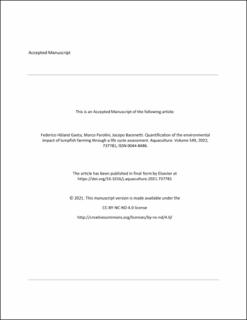| dc.contributor.author | Gaeta, Federico Håland | |
| dc.contributor.author | Parolini, Marco | |
| dc.contributor.author | Bacenetti, Jacobo | |
| dc.date.accessioned | 2022-03-16T14:02:16Z | |
| dc.date.available | 2022-03-16T14:02:16Z | |
| dc.date.created | 2021-12-06T09:06:27Z | |
| dc.date.issued | 2021 | |
| dc.identifier.citation | Aquaculture. 2021, 549, 737781. | en_US |
| dc.identifier.issn | 0044-8486 | |
| dc.identifier.uri | https://hdl.handle.net/11250/2985623 | |
| dc.description | Embargo until November 11, 2023 | en_US |
| dc.description.abstract | Infestations by the salmon louse (Lepeophtheirus salmonis Krøyer) represents the major fish health problem that the Atlantic salmon (Salmo salar) industry has to face. Sea lice infestation has a large impact on the economy of fish farmers, which are looking for a cost-effective and environmentally sustainable alternative to chemical or mechanical treatments to delouse fish. The biological control of sea lice using the so-called cleaner fish has been individuated as a feasible delousing approach of Atlantic salmons. In particular, in recent years the lumpfish (Cyclopterus lumpus) has been extensively farmed to be used as a ‘biological weapon’ in salmon farming because of its effectiveness in delousing also in harsh environmental conditions. However, the environmental impact of lumpfish farming is still largely unknown. Thus, the present study aimed at assessing the potential environmental impact of lumpfish production through a life cycle assessment (LCA) approach. Feed and electricity consumption, both for 8 of the 18 evaluated midpoint indicators, are the main responsible of the environmental load while for the Freshwater and Marine eutrophication about 90% of the impact is related to the emission of nitrogen and phosphorous compounds by fishes. These data lay the foundation for further, sustainable improvement of lumpfish farming. | en_US |
| dc.language.iso | eng | en_US |
| dc.publisher | Elsevier | en_US |
| dc.rights | Attribution-NonCommercial-NoDerivatives 4.0 Internasjonal | * |
| dc.rights.uri | http://creativecommons.org/licenses/by-nc-nd/4.0/deed.no | * |
| dc.title | Quantification of the environmental impact of lumpfish farming through a life cycle assessment | en_US |
| dc.type | Peer reviewed | en_US |
| dc.type | Journal article | en_US |
| dc.description.version | acceptedVersion | en_US |
| dc.source.pagenumber | 6 | en_US |
| dc.source.volume | 549 | en_US |
| dc.source.journal | Aquaculture | en_US |
| dc.identifier.doi | 10.1016/j.aquaculture.2021.737781 | |
| dc.identifier.cristin | 1964881 | |
| dc.source.articlenumber | 737781 | en_US |
| cristin.ispublished | true | |
| cristin.fulltext | postprint | |
| cristin.qualitycode | 2 | |

